
October 14, 2025 • 25 min read

October 14, 2025 • 25 min read
Ananya Namdev
Content Manager Intern, IDEON Labs
The difference between an ad that gets scrolled past and one that gets saved, clicked, and remembered lies in strategy, not luck. Instagram advertising has evolved dramatically, and to stay competitive, your paid Instagram posts need to combine data-driven targeting, authentic creative storytelling, and continuous optimisation.
To create Instagram ads that convert, start by understanding your audience, defining a single conversion goal, and using creative testing backed by data. Emotion-driven visuals, smart Instagram ad targeting, and consistent A/B testing help increase ROI. AI-powered ad platforms can also optimise performance automatically, saving time and boosting conversions. Master Instagram ad campaigns through systematic testing, audience segmentation, and platform-specific optimization strategies.
Meta Description: Learn how to create high-converting Instagram ads in 2025. Master Instagram advertising, targeting strategies, creative optimization, and proven tactics to boost ROI and conversions.
Instagram ads are paid Instagram posts and sponsored content that appear across the Instagram app in your feed, Stories, Reels, and Explore pages. These Instagram advertising promotions are labelled as "Sponsored" and include a clear call-to-action (CTA) such as "Shop Now," "Learn More," or "Sign Up." Unlike organic Instagram content, paid Instagram posts are managed through Meta Ads Manager, which allows you to control every aspect of your Instagram ad campaign, including targeting by age, interests, behaviour, and location.
Paid Instagram posts can take multiple formats from simple image ads to immersive video content, making Instagram promotion flexible for any business objective. Whether you're launching an Instagram ad campaign for brand awareness or driving conversions, understanding how Instagram advertising works is essential. To get started with Instagram ads, first create an Instagram business account and connect it to Meta for Business. The integration between Instagram and Meta Ads Manager makes it easier to launch, monitor, and scale your paid Instagram posts efficiently across multiple audience segments.
Meta Description: Learn what Instagram ads are, how paid Instagram posts work, and how to set up Instagram advertising through Meta Ads Manager for your brand.
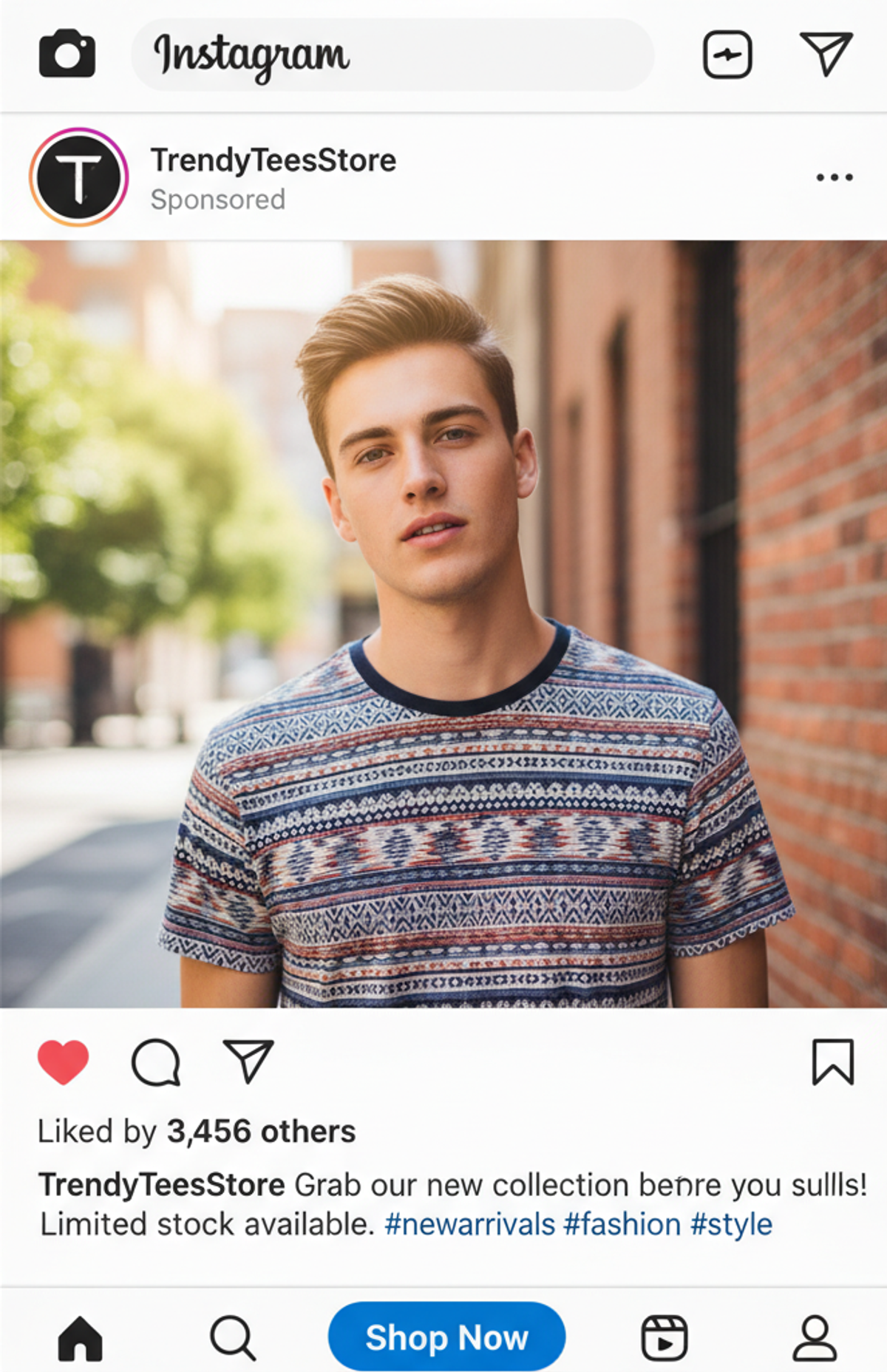
A perfect example of an Instagram ad in the feed! Look for the "Sponsored" tag and the clear "Shop Now" button. That's the power of Meta Ads Manager at work, turning a simple post into a highly targeted promotion.
With 2.3 billion monthly users, Instagram remains one of the most conversion-friendly platforms for brands. The platform's advanced targeting capabilities, combined with its visual-first nature, make it ideal for businesses across industries.
Short-form video and AI-personalised content outperform static posts. Video-based Instagram advertising delivers significantly higher engagement and conversion rates compared to traditional static image ads.
Across 80 campaigns analysed:
Why these metrics matter: They demonstrate that Instagram ad campaign success depends on choosing the right format and creative approach. Video-based Instagram advertising continues to dominate, making it essential to prioritise Reels and video content in your Instagram promotion strategy.
Instagram Reels as the future of Instagram advertising: Meta is prioritizing Reels placement, making them the most cost-effective Instagram ads format in 2025. Brands adopting Reels-focused strategies see measurably better ROI compared to static image ads.
AI-driven optimization: Instagram's automated bidding and dynamic creative optimization features reduce the manual work required to run successful Instagram ad campaigns. Brands leveraging AI in their Instagram advertising see faster results and lower CPA.
Instagram offers multiple ad formats, each suited for different campaign objectives and audiences. Understanding which Instagram ad formats work best for your goals is crucial for Instagram ad campaign success.
Image Ads: The simplest Instagram advertising format, appearing in Feed or Explore. Image ads are great for product launches, brand awareness, and driving clicks to your website. CTA example: Shop Now. Best for: Budget-conscious brands testing Instagram advertising for the first time.
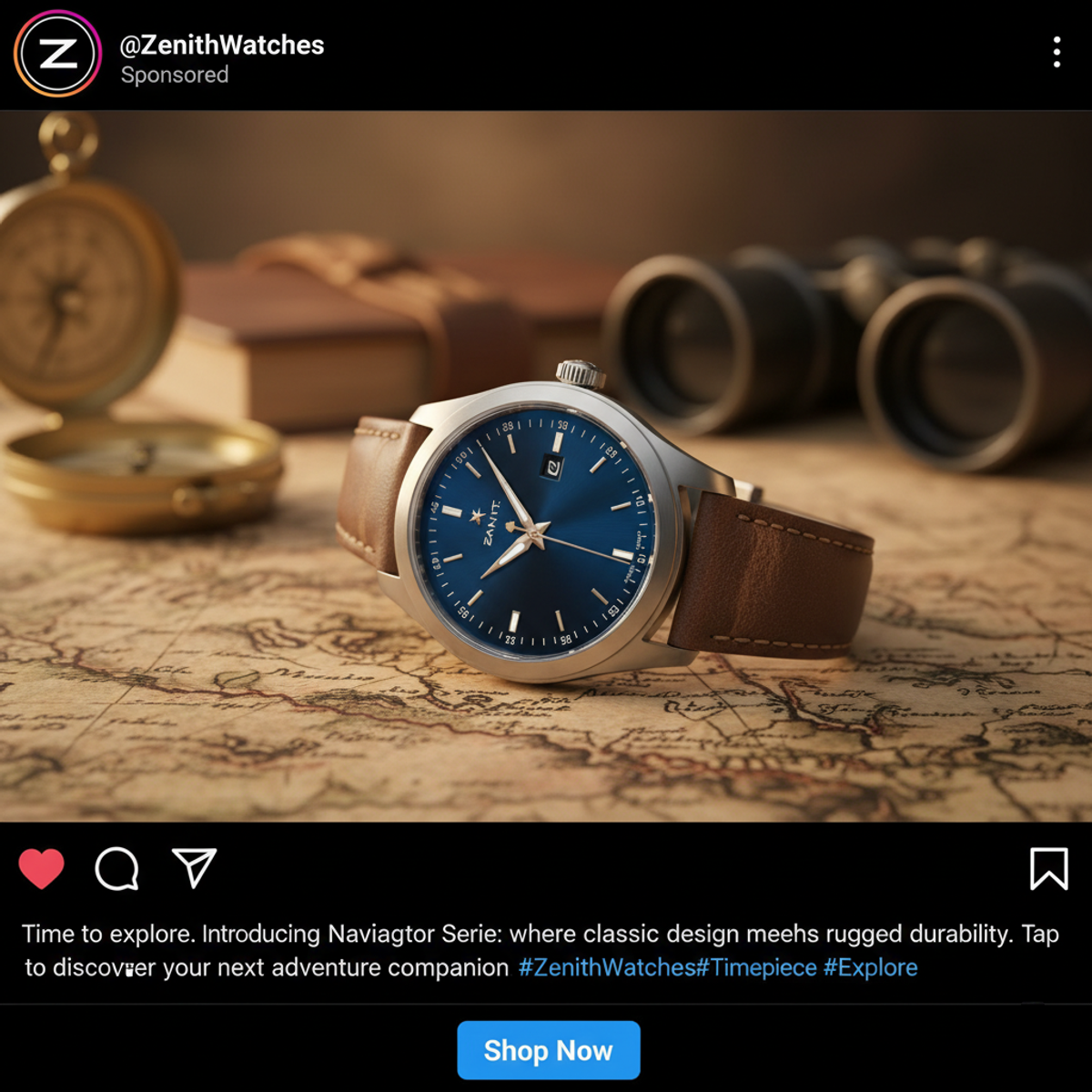
This Zenith Watches ad perfectly illustrates the power of the Image Ad format. It uses a single, high-quality photograph to immediately convey the product's aesthetic and theme (adventure/durability). By including a strong, clear "Shop Now" CTA, it fulfills the format's primary goal: driving direct clicks and sales without the complexity of a carousel or video. This simplicity makes it ideal for testing new products or maximizing ROI for budget-conscious brands.
Video Ads: Available in Reels, Stories, or Feed, video ads are ideal for product demos, customer testimonials, or storytelling. Video-based Instagram advertising drives superior engagement. CTA example: Watch More. Best for: Showcasing product features or building an emotional connection.
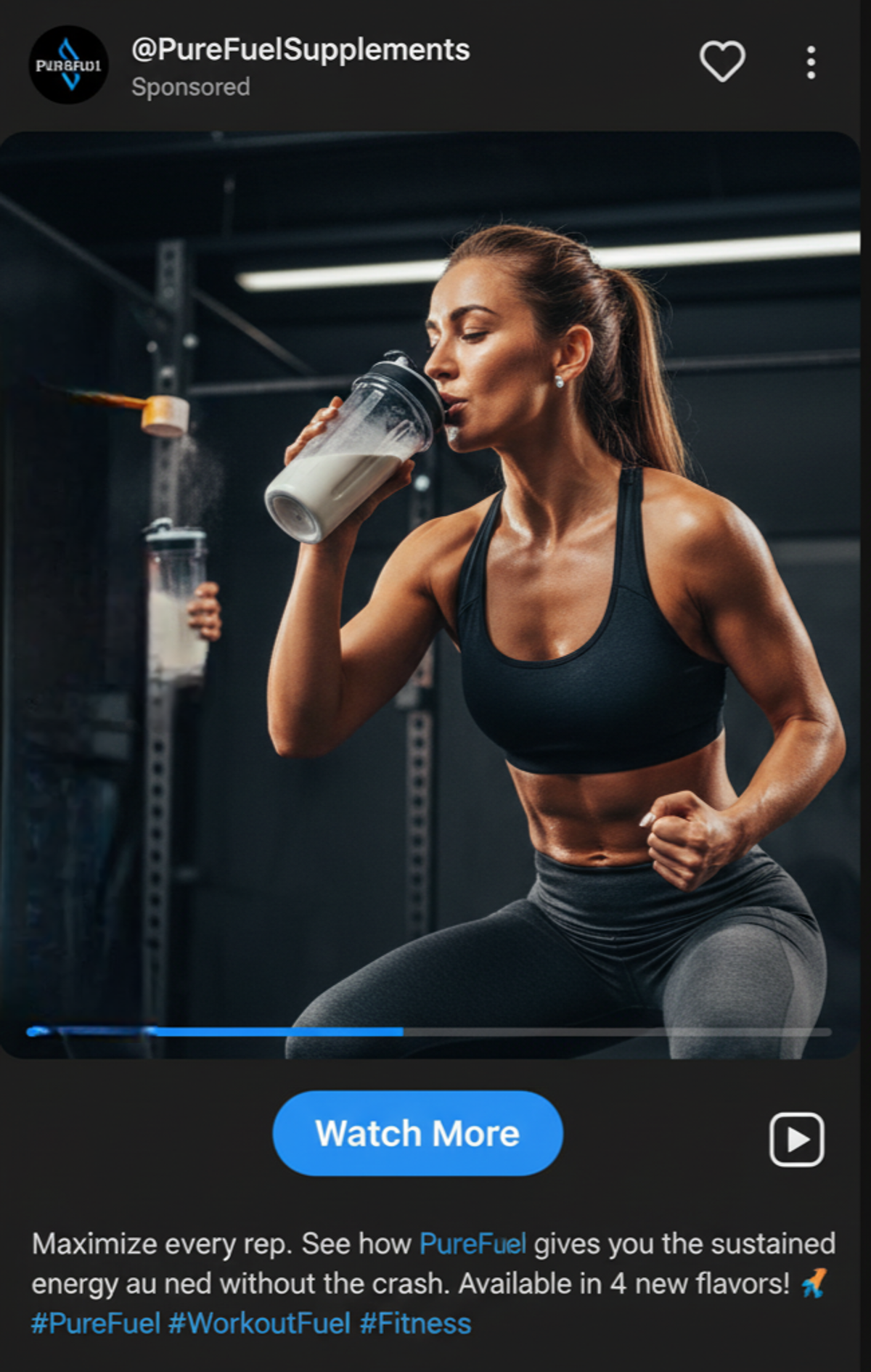
This PureFuel Supplements ad perfectly demonstrates the effectiveness of the Video Ad format. While we see a still frame, the implied motion of the video would allow for a dynamic product demo—showing the woman actively working out and then consuming the supplement. This format is ideal for showcasing benefits like "sustained energy" (perhaps through clips of her maintaining intensity) and building an emotional connection with the target audience (fitness enthusiasts) by depicting a relatable, aspirational scene. The "Watch More" CTA is perfect for inviting deeper engagement with the brand's story or product features, which is a key advantage of video-based advertising.
Carousel Ads: Multi-image Instagram ads in Feed format, perfect for showcasing multiple products or highlighting different product benefits. Carousel ads encourage users to interact with your Instagram promotion by swiping through images. CTA example: Swipe Left. Best for: E-commerce brands and product-heavy Instagram advertising campaigns.
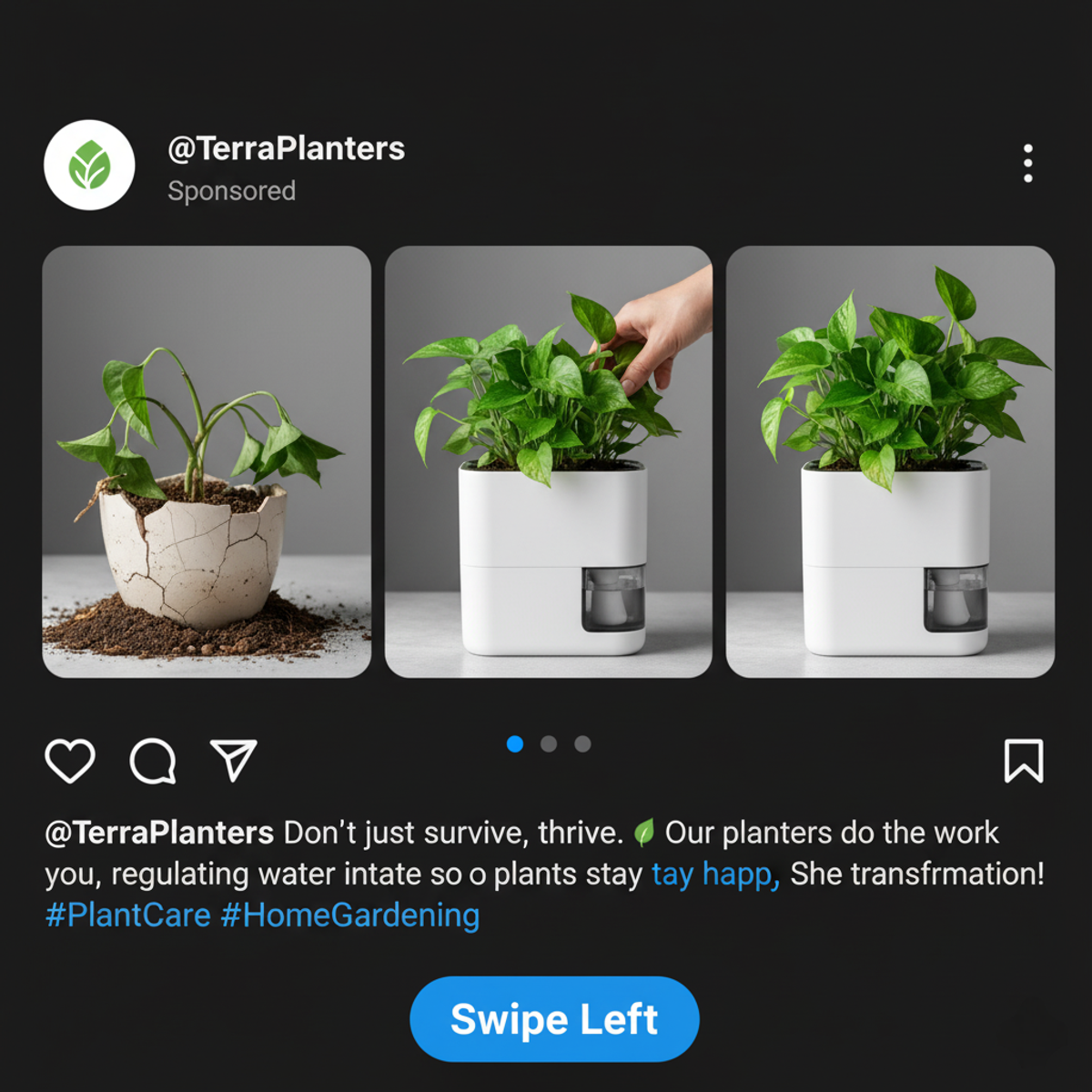
The TerraPlanters ad perfectly utilizes the Carousel Ad format by telling a complete story across multiple slides. Instead of just showing the final product, it effectively highlights a problem (dying plant), introduces the solution (the self-watering planter), and shows the result (a thriving plant). This multi-step narrative is compelling and encourages users to fulfill the ad's main objective: 'Swipe Left' to interact and see the full picture. This format is ideal for e-commerce, allowing the brand to showcase different features, product colors, or, in this case, a dramatic 'before-and-after' transformation.
Story Ads: Instagram advertising placed between user Stories, ideal for flash sales or time-sensitive offers. Story ads have a 3.8% conversion rate and feel native to the Stories experience. CTA example: Tap to Shop. Best for: Urgent offers and driving immediate conversions.
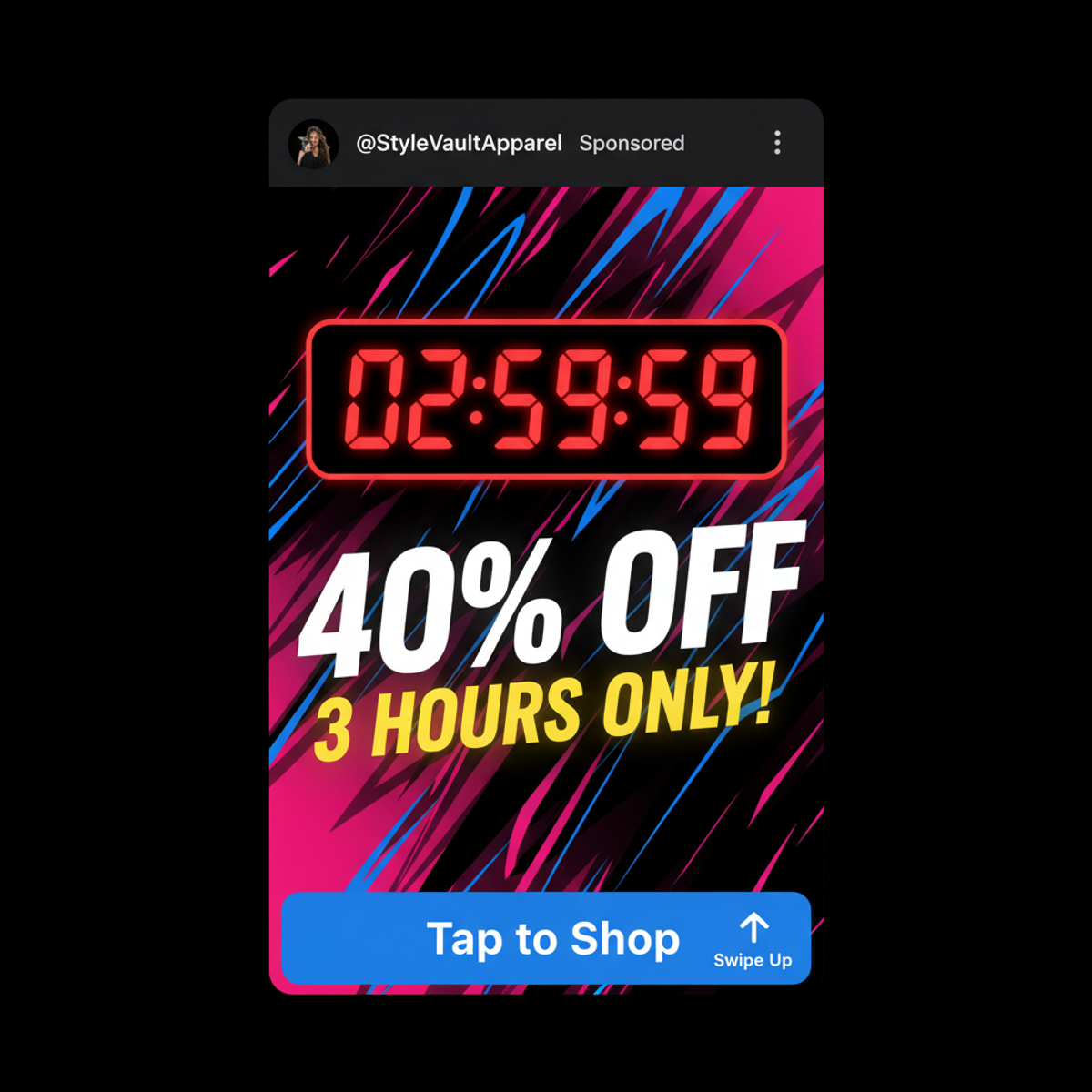
This StyleVaultApparel ad showcases the ideal use of the Story Ad format for a time-sensitive offer. The ad is full-screen, visually aggressive, and uses a large, visible countdown timer to create extreme urgency—a key element for the high conversion rates seen in Story Ads. Because users are already quickly tapping or swiping through Stories, the clear, powerful call-to-action, "Tap to Shop" (or Swipe Up), capitalizes on this rapid user behavior, making it highly effective for driving immediate conversions during a short-term flash sale.
Reel Ads: Appear in the Reels tab or Feed, these short-form video ads have the highest conversion rate (4.1%) among all Instagram ad formats. Reel ads blend seamlessly with organic Reels content. CTA example: Learn More. Best for: Maximum conversions and reach with authentic video content.
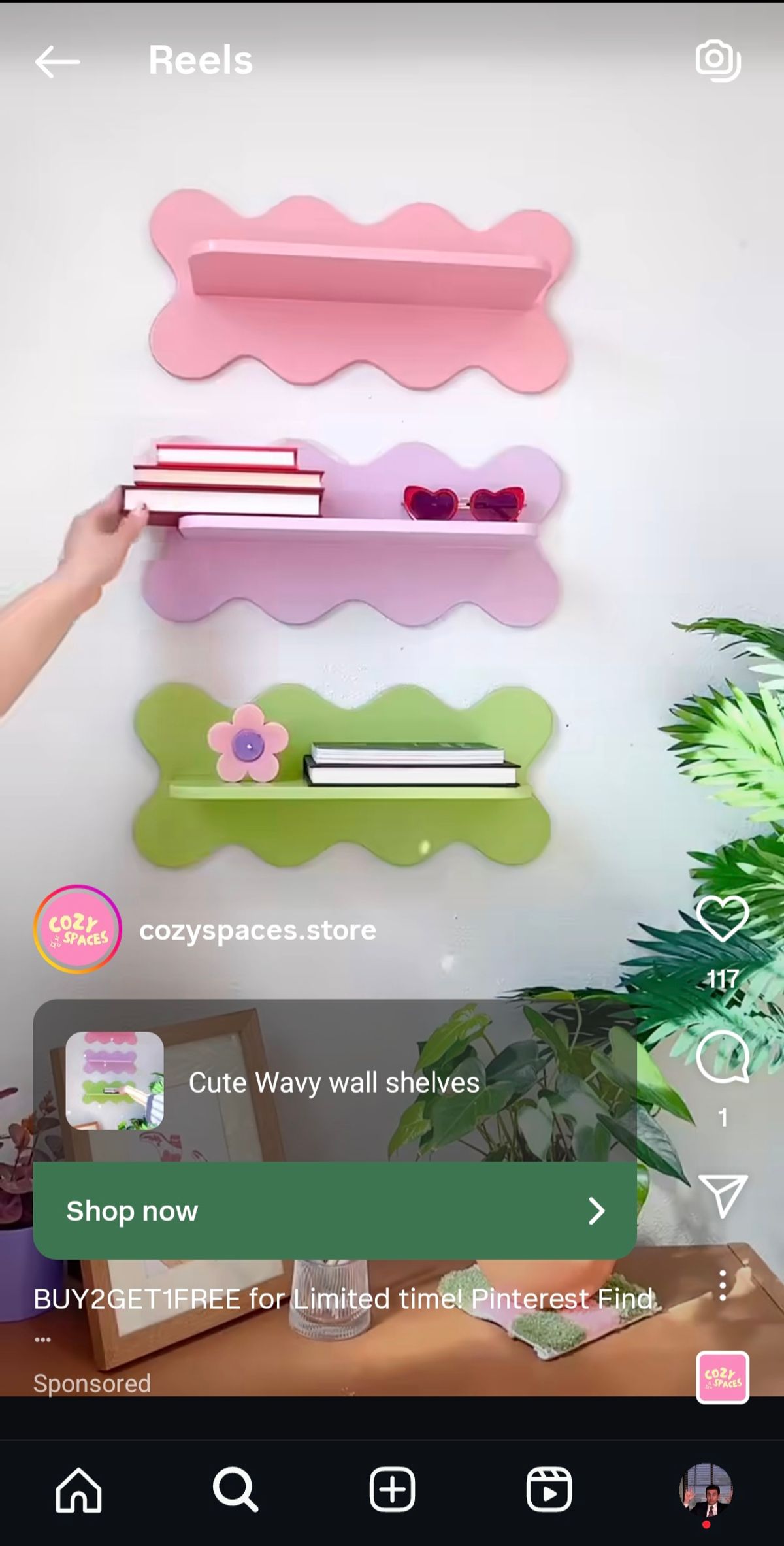
This cozyspaces.store ad demonstrates why Reel Ads achieve the highest conversion rates. The short-form video (implied by the still) likely shows the shelves being installed or styled, offering a quick, authentic product demonstration that feels native to the Reels environment. By immediately showcasing the product's aesthetic and usefulness, the ad maximizes engagement. Crucially, it combines a direct "Shop now" CTA with a compelling incentive ("BUY 2 GET 1 FREE"), leveraging the high reach and engagement of the Reels tab for maximum conversions and broad audience reach.
Collection Ads: Feed ads that display a product catalogue, ideal for e-commerce lookbooks and browsing experiences. Collection ads allow users to browse and purchase without leaving Instagram. CTA example: Browse Now. Best for: Showcasing product variety in your Instagram advertising.
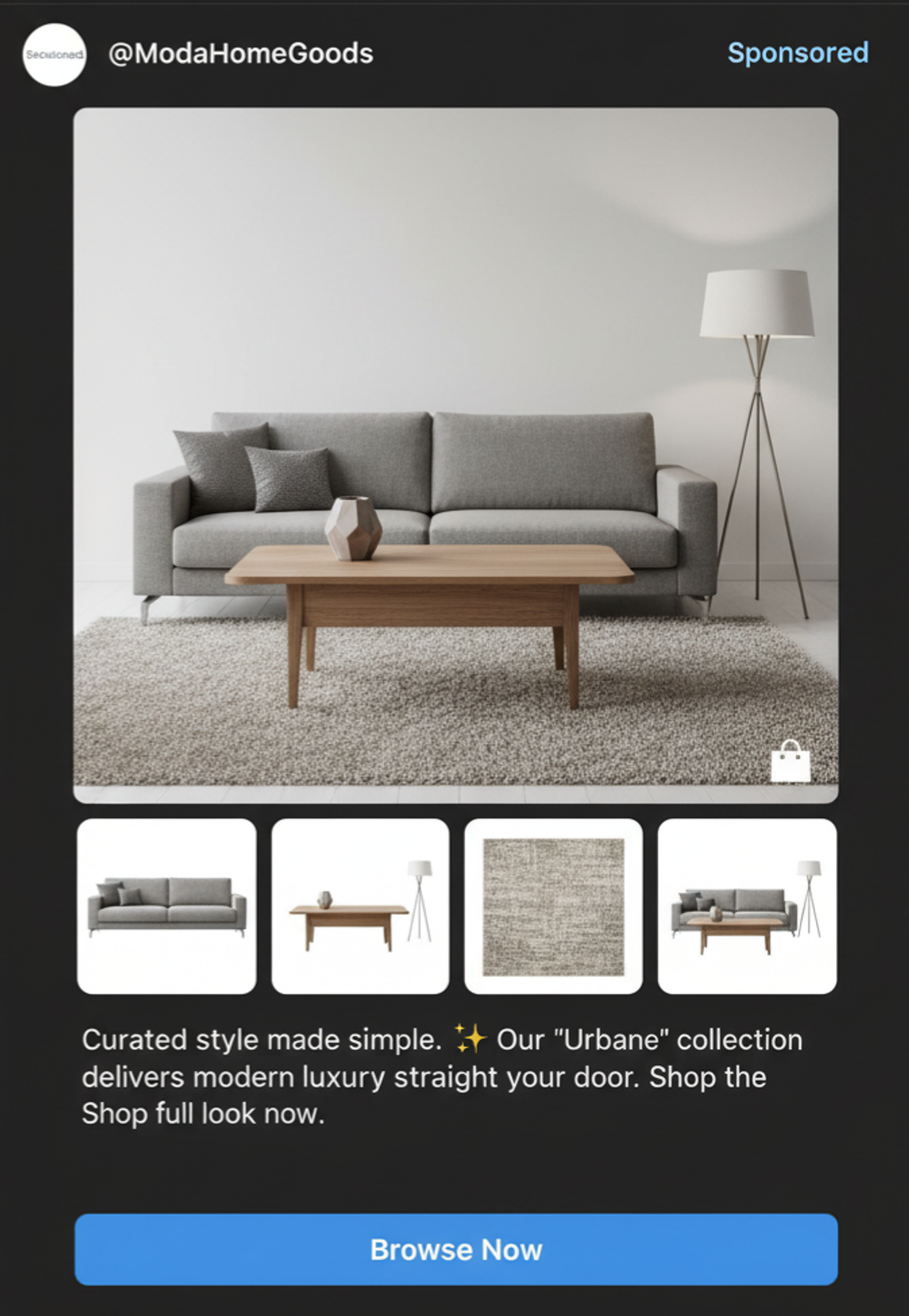
The ModaHomeGoods ad beautifully demonstrates the power of the Collection Ad format. By using a main lifestyle image to showcase the entire look (the "Urbane" collection), and then providing smaller thumbnail images for the individual components (sofa, table, rug), it serves as a digital lookbook. This format is highly effective for e-commerce brands, as it allows users to 'Browse Now,' view the product catalogue, and even make purchases without ever leaving the Instagram app. This seamless browsing experience makes it the perfect choice for showcasing product variety and offering complete, styled ensembles.
Shopping Ads: Enable direct product purchases from Feed or Explore without leaving the app. Shopping ads streamline the purchase path, reducing friction. CTA example: Buy Now. Best for: Direct e-commerce sales and driving revenue through Instagram promotion.
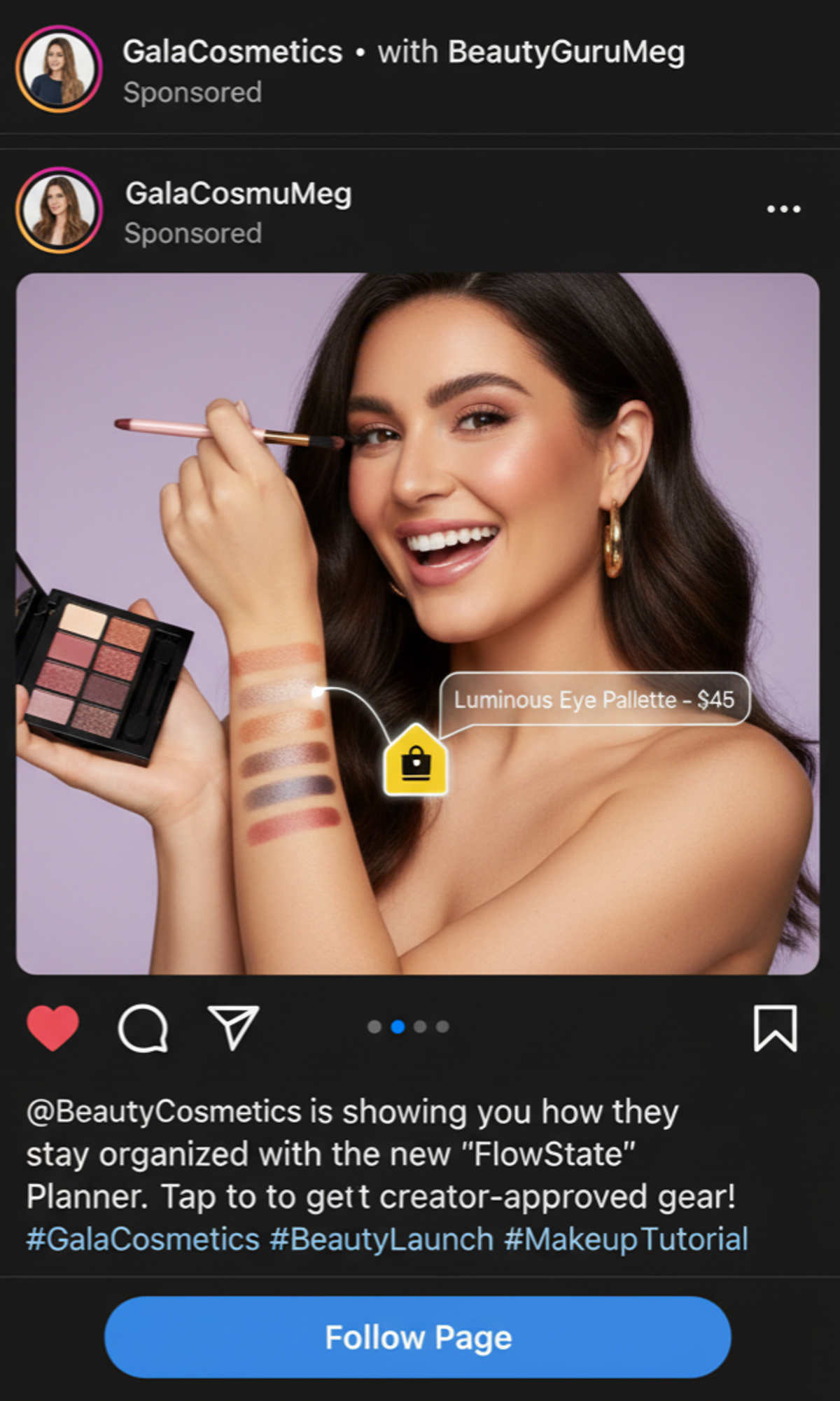
This GalaCosmetics ad, featuring influencer BeautyGuruMeg, is a prime example of a highly optimized Shopping Ad. The ad's brilliance lies in the direct product tag visible on the screen—the 'Luminous Eye Palette - $45'—which allows a user to tap and immediately initiate a purchase without leaving the Instagram app. This seamless, in-app checkout experience dramatically reduces the purchase path friction. By combining the trust of an influencer with the direct sales functionality of the shopping tag, this format is highly effective for driving direct e-commerce sales and immediate revenue. (Note: Although the CTA is "Follow Page," the core functionality is the Shoppable tag, making it a Shopping Ad.)
Explore Ads: Placed on the Explore page to reach new audiences interested in similar content. Explore ads are effective for brand discovery and reaching cold audiences. CTA example: View Post. Best for: Expanding reach beyond your existing follower base.
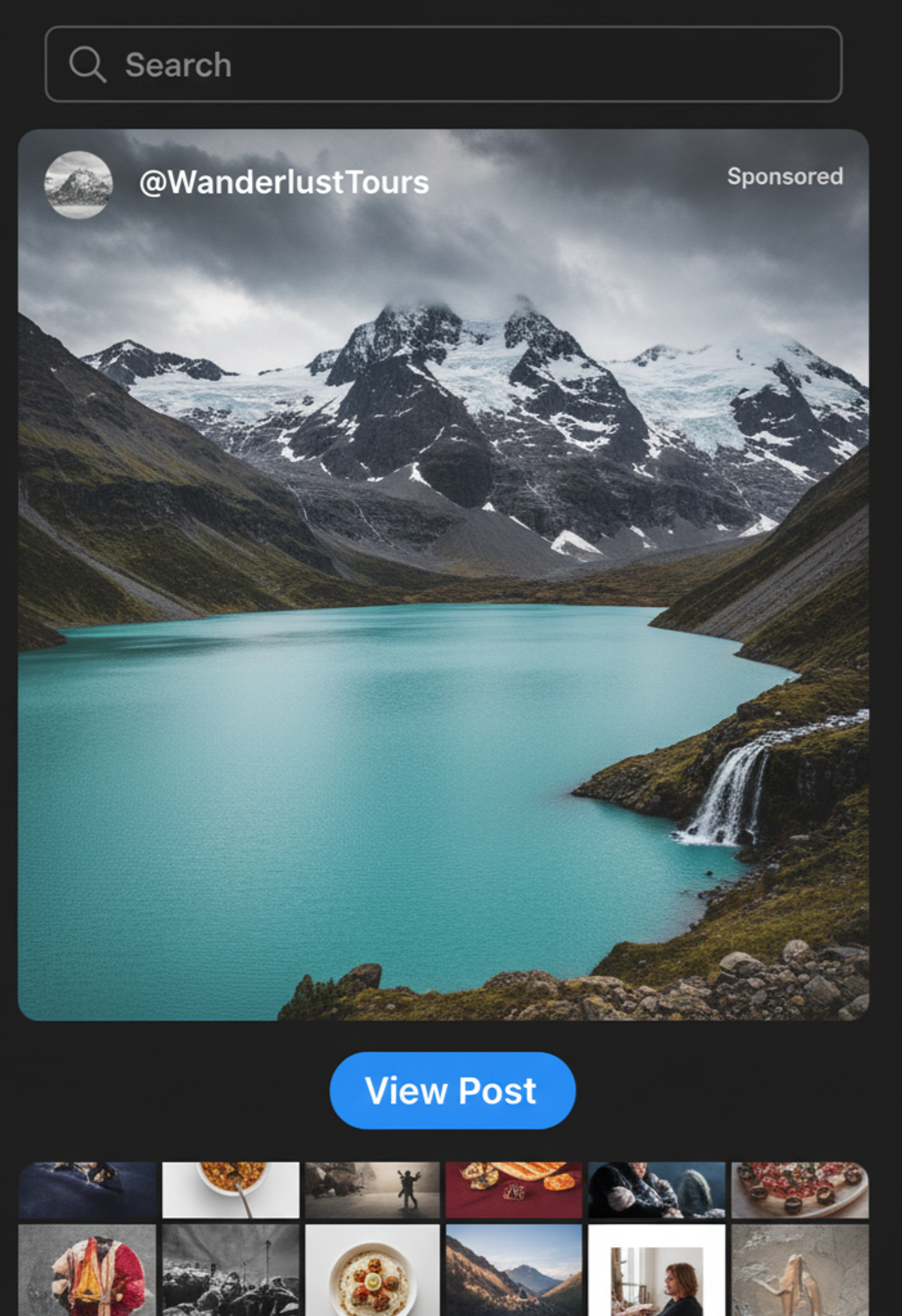
This breathtaking Wanderlust Tours ad demonstrates the ideal use of the Explore Ad format. Placed on the Explore page, its stunning, high-quality image of a remote mountain lake is strategically targeted at users already showing an interest in travel and adventure content (a "cold audience"). The goal here is not an immediate sale, but brand discovery and reach expansion. The soft "View Post" CTA encourages the user to tap through and discover the full post or profile, effectively pulling new, highly relevant users into the brand's ecosystem for future marketing.
Reminder Ads: Promote events via Feed or Stories, allowing users to set reminders. Reminder ads are effective for event-driven Instagram advertising campaigns. CTA example: Remind Me. Best for: Webinars, product launches, and scheduled events.

Although the image shows a "Tap to Shop" CTA, its design is perfectly suited for a Reminder Ad. The central element the large, urgent countdown timer and limited-time offer is exactly what you want to leverage for an event-driven campaign. If the call-to-action were "Remind Me," users could instantly receive a notification just before the sale (the event) begins. This feature makes Reminder Ads highly effective for product launches, webinars, or, as shown here, time-limited flash sales, ensuring users don't miss the scheduled moment and maximizing attendance or sales on the day of the event.
Collab Ads: Shared between creators and brands, perfect for influencer campaigns and partnership-driven Instagram advertising. Collab ads expand reach through creator audiences. CTA example: Follow Page. Best for: Influencer partnerships and co-marketing initiatives.
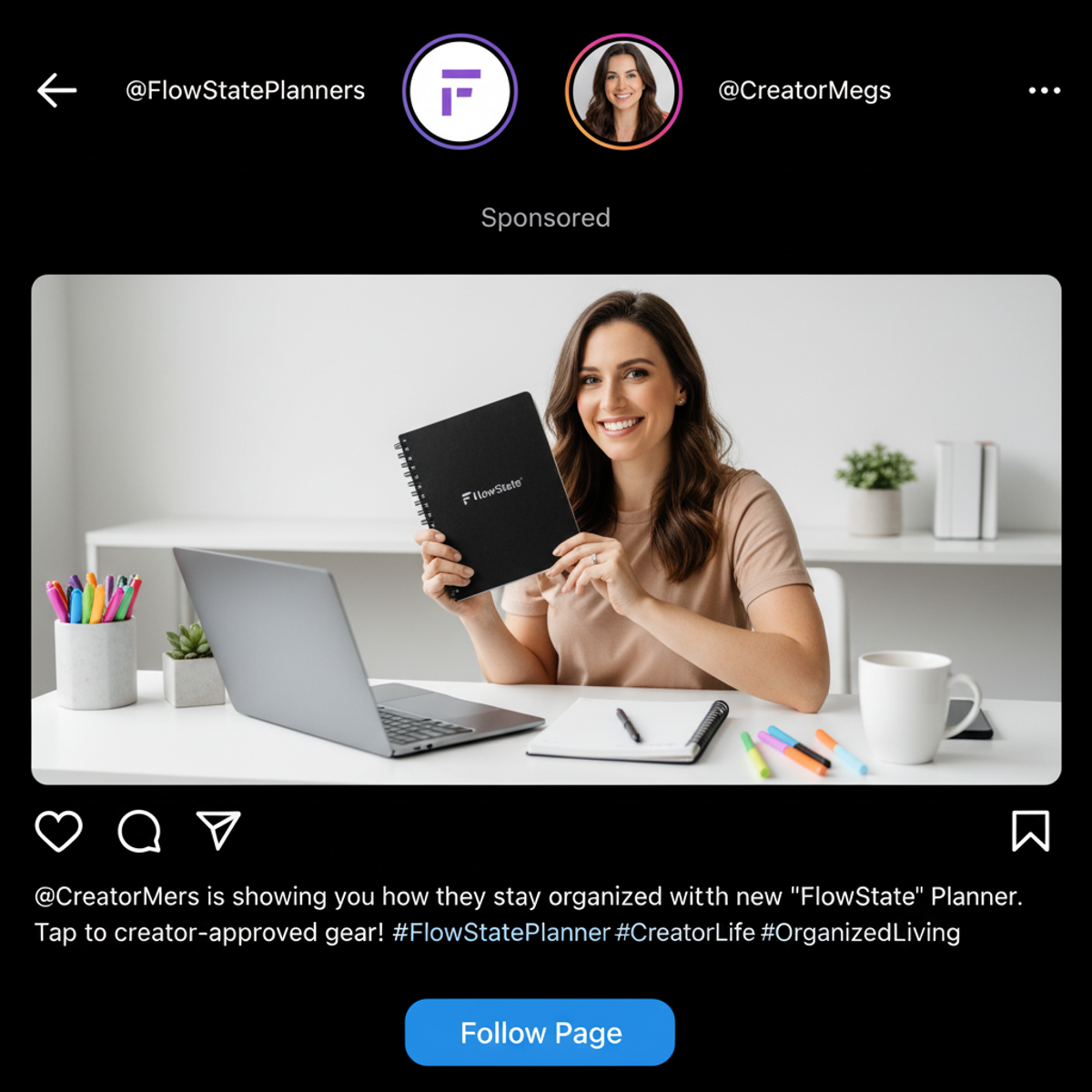
This ad, featuring @FlowStatePlanners and @CreatorMegs, is a textbook example of a Collab Ad. The dual profile icons at the top immediately signal the official partnership, lending the advertisement authenticity and credibility. By being run as a Collab Ad, the content is simultaneously pushed to the audiences of both the brand and the creator, significantly expanding reach and tapping into the creator's engaged community. The "Follow Page" CTA is strategically chosen to convert the newly reached creator audience into long-term brand followers, making this format perfect for co-marketing and influencer-driven campaigns.
Data from 2024–2025 reveals clear performance leaders in Instagram advertising:
Reels Ads have the highest conversion rate at 4.1%, outperforming all other Instagram ad formats by a significant margin. Reel ads combine authentic short-form video content with native placement, creating a seamless user experience that drives conversions.
Story Ads achieve a 3.8% conversion rate, making them the second-highest converting format. Story ads work particularly well for time-sensitive offers and direct response campaigns.
Carousel Ads deliver a 27% increase in retention, making them ideal for engagement-focused Instagram advertising campaigns even if conversion rates are slightly lower.
They blend into native content, keeping engagement authentic. Users experience Reels ads and Story ads as native content rather than disruptive advertisements. This authentic feel increases engagement and conversion likelihood.
Videos with human emotion, movement, and storytelling outperform static posts. Instagram advertising success depends on emotional resonance. Videos featuring real people, genuine testimonials, and relatable scenarios drive 2.1× higher engagement than static images.
Vertical video format matches Instagram's native design. Reels and Stories are designed for vertical viewing, making vertical video ads the ideal Instagram advertising format for this platform.
Pro Tip: Use vertical short-form videos with captions, emotion-led hooks, and a clear CTA in the first 3 seconds for maximum Instagram ad campaign performance. The first 3 seconds determine whether users continue watching or scroll past your Instagram advertising.
Creating high-converting Instagram ads requires a strategic approach combining audience insights, creative excellence, and continuous optimization. This comprehensive guide walks you through building effective Instagram ad campaigns from start to finish.
Before launching any Instagram ad campaign, connect your Instagram profile to Meta Ads Manager and establish conversion tracking. This involves setting up the Meta Pixel on your website to measure how users interact with your Instagram ads after clicking through.
Proper conversion tracking ensures you can accurately measure ROI and optimize your Instagram ad targeting based on real performance data. Without conversion tracking, you're flying blind. You'll know impressions and clicks, but not whether your Instagram advertising is driving actual business results.
For detailed guidance, see: How to Set Up Your Facebook Ads Account
Choose a single, measurable conversion metric for your Instagram ad campaign: clicks, signups, purchases, messages, or video views. Your objective should directly align with your business goals.
Ads with a clearly defined objective see 35% lower CPA and significantly better ROI. Your Instagram advertising objective should be as specific as possible.
Pro tip: For your first Instagram ad campaign, choose one primary objective. Multi-objective campaigns are confusing to Meta's algorithm and typically underperform compared to single-objective campaigns focused on a specific conversion metric.
Successful Instagram ad targeting goes beyond basic demographics. Use Meta Audience Insights or AI-powered tools to build detailed audience personas based on behaviour, interests, and emotional triggers.
Narrow targeting: Target specific interests and behaviours (e.g., "women interested in skincare eco-friendly products"). Narrow targeting typically delivers lower CPA but smaller reach.
Broad targeting: Target large demographic groups with minimal interest restrictions. Broad targeting reaches more people but may have a higher CPA.
Lookalike audiences: Meta identifies users similar to your best customers. Lookalike audiences balance reach and relevance.
Custom audiences: Retarget people who've visited your website, engaged with your content, or opened your emails. Custom audiences typically have a lower CPA than cold audiences.
Layered targeting: Combine multiple targeting parameters (interests + behaviours + demographics) for precision. Test whether layered or simplified targeting performs better for your Instagram ad campaign.
Testing framework: Create multiple Instagram ad campaigns targeting different segments. Let each campaign run for 3–5 days with a ₹500+ budget to generate meaningful data. Identify your best-performing audience segment and allocate more budget to winners.
Follow the 3E formula for Instagram ad creative: Emotion + Engagement + Eye Contact. Your Instagram advertising creative should tell a story, not just showcase a product.
Lead with your strongest visual: The first frame of your Instagram ad is critical. Use your most compelling image or video frame to stop the scroll immediately. Users typically spend 0.5–1.5 seconds deciding whether to engage with your Instagram advertising.
Use authentic, relatable imagery: Real customer photos, behind-the-scenes content, and lifestyle shots outperform polished stock photography in Instagram advertising. Authenticity builds trust and drives higher engagement with your Instagram ad campaign.
Incorporate human faces: Ads featuring recognizable faces (especially eyes making direct contact with the camera) drive 38% higher engagement. For Instagram advertising, prioritize human connection.
Create emotion through storytelling: Show the transformation your product enables. Instagram advertising works best when it tells a compelling story, not just lists product features.
Match brand aesthetics: Maintain consistent colours, fonts, and visual style across all your Instagram ads. Consistency builds brand recognition and trust, making your Instagram advertising instantly recognisable to your target audience.
Optimise for mobile viewing: Remember that all Instagram advertising is viewed on mobile devices. Ensure text is readable, visuals are clear, and key information doesn't get cut off on small screens.
Your Instagram ad copy should speak directly to your audience's pain points or desires. Use active verbs, emotional language, and short sentences.
Example of strong Instagram ad copy: "Find your glow. Shop the serum everyone's talking about."
Lead with a benefit, not a feature: Instead of "Our serum contains hyaluronic acid," try "Get hydrated skin in 7 days or your money back."
Use conversational, relatable language: Write as if you're talking to a friend, not writing corporate marketing copy. This approach makes your Instagram advertising feel more authentic.
Keep it concise: Most users scroll quickly through Instagram. Your ad copy should be scannable, with your main message conveyed in the first sentence or two.
Include social proof: Mention customer testimonials, ratings, or how many customers you've helped. Social proof builds credibility for your Instagram ad campaign.
Create urgency: Use language like "Limited time," "Only X spots left," or "Shop before it's gone." Urgency drives immediate action on Instagram advertising.
Strong call-to-action (CTA) examples:
A/B testing your copy: Create multiple variations of your Instagram ad copy within the same campaign. Test different headlines, benefits, and CTAs to identify which messaging resonates best with your target audience.
Test 2–3 variations of each element to identify top performers and eliminate underperforming creatives. This systematic approach to Instagram ad optimization helps maximize ROI across your Instagram advertising efforts.
Elements to test in your Instagram ad campaign:
A/B testing best practices:
Test one variable at a time: Change only one element (headline) while keeping everything else identical. This reveals which specific change drove performance differences.
Run tests for 3–5 days minimum: Give each Instagram ad campaign enough time and budget to generate meaningful data (aim for 100+ impressions per variation).
Use statistical significance: Prioritize results where performance differences are statistically significant (not just luck). Meta provides confidence levels in Ads Manager.
Document all tests: Keep records of what you tested, results, and learnings. This historical data improves future Instagram ad campaigns.
Scale winners incrementally: Once you identify high-performing Instagram ads, increase their budget by 20–30% every 3–5 days rather than doubling budget immediately.
Use Meta Ads Manager dashboards to monitor performance in real time. Identify which Instagram ad variations drive the lowest CPA and highest conversion rate.
Key metrics to track daily:
CTR (Click-Through Rate): Percentage of impressions that result in clicks. A good Instagram ad CTR is 0.8–1.5%; above 2% is excellent.
CPC (Cost Per Click): Average cost of each click from your Instagram advertising. Lower CPC indicates more efficient targeting or more compelling ad creative.
CPM (Cost Per Thousand Impressions): Average cost to reach 1,000 people with your Instagram ads. Varies widely by niche and audience.
ROAS (Return on Ad Spend): Revenue generated divided by amount spent on Instagram advertising. Target ROAS of 3:1 or higher for profitable campaigns.
Conversion Rate: Percentage of clicks that result in desired action (purchase, signup, etc.). Track this closely to identify which Instagram ads drive actual business results.
Cost Per Conversion: Total campaign spend divided by number of conversions. Use this to determine if your Instagram ad campaign is economically viable.
Cost Per Lead (for lead generation): Total spend divided by number of leads generated. Compare against your customer acquisition cost target.
Making data-driven adjustments:
Optimization cycles: Most successful Instagram advertising follows a continuous improvement cycle launch, analyze, optimize, test new creative, analyze again. This ongoing process is how high-performing Instagram ad campaigns sustain results over time.
Optimizing your Instagram advertising requires both creative excellence and strategic refinement. These evidence-based best practices will help you maximize conversions and ROI across all your paid Instagram posts.
Keep videos under 15 seconds. Short-form video content dominates Instagram, especially on Reels. Videos between 6–15 seconds maximize watch-through rates and maintain viewer attention throughout your Instagram ad campaign. Longer videos risk users stopping before reaching your CTA.
Include captions and subtitles on all videos. Over 80% of Instagram users watch videos without sound. Adding closed captions ensures your message comes through even when viewers mute audio, significantly improving engagement with your Instagram advertising content.
Lead with your strongest visual in the first 3 seconds. The first 3 seconds of your Instagram ad determine whether users stop scrolling or keep moving. Open with your most compelling image or video frame to hook attention immediately. Test different opening visuals to identify which generates the highest completion rate.
Use authentic, emotion-driven storytelling. Avoid generic product shots. Show real customer testimonials, before-and-after transformations, behind-the-scenes content, or relatable scenarios that connect emotionally with your audience. This approach makes your Instagram ads feel less like advertising and more like genuine recommendations.
Test multiple headlines and ad copy variations. Different audience segments respond to different messaging. Run multiple variations of headlines and copy within the same Instagram ad campaign to identify which resonates best with your target audience. Document what works for future campaigns.
Optimize for mobile-first viewing. All Instagram advertising is consumed on mobile devices. Ensure text is readable at small sizes, important information appears in the top half of your ad creative, and visuals are optimized for vertical viewing. Test how your ads appear on different phone sizes.
Use bright, contrasting colors: Colors that stand out in busy Instagram feeds (bright yellows, oranges, pinks) typically generate higher engagement. However, ensure color choices align with your brand identity.
Maintain consistent branding and visual aesthetics. Your Instagram ads should reflect your brand identity across colors, fonts, tone, and messaging. Consistency builds brand recognition and trust over time as users see your Instagram advertising repeatedly.
Refresh creatives every 2–3 weeks. Instagram users become "ad fatigued" when exposed to the same visual repeatedly. Rotating new Instagram ad creative regularly maintains high engagement and relevance scores throughout your advertising campaign. Plan creative production to support ongoing rotation.
Implement frequency capping. Set limits on how many times the same user sees your Instagram ad within a given period (e.g., maximum 3 times per week). Too much frequency increases costs and reduces effectiveness, while strategic frequency builds brand recall.
Use dynamic creative optimization (DCO). Meta's DCO feature automatically tests combinations of headlines, ad copy, images, and videos to find the highest-performing Instagram ads. This accelerates Instagram ad optimization and reduces manual testing time.
Implement sequential messaging: Show different creatives to warm audiences (who've visited your site) versus cold audiences (new prospects). This tiered approach improves Instagram ad performance by matching the right message to each audience stage.
Monitor audience overlap: If running multiple Instagram ad campaigns simultaneously, check for audience overlap in Ads Manager. Overlapping audiences can drive up costs and create ad fatigue. Adjust targeting to minimise overlap.
Build custom and lookalike audiences. Create custom audiences from your existing customers or website visitors. Then build lookalike audiences that mirror these high-value segments. Lookalike audiences expand your reach while maintaining relevance for your Instagram advertising efforts. Start with 1% lookalike audiences (most similar) before expanding to 5–10%.
Layer your Instagram ad targeting parameters strategically. Combine multiple targeting options, interests, behaviours, demographics, and custom audiences to reach a precise audience segment. However, test whether narrow targeting delivers better results than broad targeting. Sometimes, broad targeting with good creative outperforms narrow targeting.
Test different audience segments within the same campaign. Rather than assuming one audience performs best, create multiple Instagram ad campaigns targeting different segments. Use performance data to identify your most valuable audience for future Instagram ad optimisation.
Use audience insights to refine targeting. Review the "Audience" tab in Meta Ads Manager to see demographics of people engaging with your Instagram ads. Use this data to refine your targeting parameters for future campaigns.
Create retention audiences: Build custom audiences of people who've made purchases or completed high-value actions. Test whether retention audiences have lower CPA than acquisition audiences (they often do).
Test cross-sell and upsell audiences: For e-commerce brands, create audiences of existing customers and test promoting complementary or higher-value products. These audiences often have superior conversion rates and ROAS.
Track these key metrics daily: CTR (Click-Through Rate), CPC (Cost Per Click), CPM (Cost Per Thousand Impressions), ROAS (Return on Ad Spend), Conversion Rate, and Cost Per Conversion. These metrics reveal which Instagram ads are driving genuine business results.
Start with ₹500-₹1000 per day for testing before scaling your Instagram advertising budget. This gives you enough data (typically 100–200 impressions per day) to identify winning creatives and audience segments without overcommitting resources.
Establish a testing budget: Allocate 20–30% of your Instagram advertising budget to testing new creatives, audiences, and messaging. The remaining 70–80% should go to proven winners that consistently deliver results.
Scale winners incrementally. Once you identify high-performing Instagram ads, increase their budget by 20–30% every 3–5 days. This gradual scaling approach reduces risk and allows Meta's algorithm to optimise performance at each budget level.
Pause underperformers quickly. If an Instagram ad or audience segment has not generated conversions after 100–150 impressions, consider pausing it and reallocating the budget to better performers. Don't waste money on consistently underperforming Instagram advertising.
Calculate your break-even CPA: Determine the maximum you can afford to pay per conversion and still maintain profitability. If your Instagram ad campaign CPA exceeds this threshold, pause the campaign and test new creative or targeting.
Monthly budget review: Analyze month-over-month performance of your Instagram advertising. Identify trends, seasonal patterns, and opportunities for optimization.
Use video testimonials and user-generated content (UGC). Social proof is powerful. Customer testimonials, reviews, and UGC-based Instagram ads typically convert 30–40% better than brand-created content. Encourage customers to share videos of them using your product.
Test carousel ads for product showcasing. Carousel-format Instagram ads allow users to swipe through multiple products or features. This format typically increases engagement and time spent interacting with your Instagram ad. Use carousels to showcase product variety or tell a multi-step story.
Leverage Instagram Stories ads for urgency. Story ads work particularly well for time-sensitive offers like flash sales or limited-time promotions. The vertical format and native placement make Stories an underutilised opportunity in many Instagram advertising strategies.
Combine Instagram ads with Reels for amplified reach. Reels ads currently have the highest conversion rate (4.1%) among all Instagram ad formats. If you're creating video content for your Instagram advertising, prioritize Reels placement. Reels have massive reach potential, especially for new accounts.
Implement retargeting sequences: Create a series of Instagram ads targeting people at different stages of the customer journey. New visitors see an awareness-focused ad, while repeat visitors see product-focused ads. This sequential approach improves overall campaign performance.
Test shopping ads for e-commerce: If you operate an e-commerce business, experiment with Instagram Shopping ads. These ads reduce friction by enabling purchases without leaving Instagram, typically driving higher conversion rates.
Use collection ads for product browsing: Collection ads create a browsable catalog experience within Instagram. Perfect for showcasing multiple products to audiences exploring your brand for the first time.
Test messenger ads for lead generation: For B2B or service businesses, Messenger ads can efficiently generate qualified leads by starting conversations directly within Messenger.
Implement lead forms: For lead generation campaigns, use Instagram's native lead form feature. Lead forms pre-fill known information, reducing friction and increasing conversion rates compared to directing users to external landing pages.
For deeper insights into Instagram advertising and optimization, refer to these authoritative resources:
Explore these related sections to deepen your Instagram advertising expertise:
Meta Description: Master Instagram ad best practices including creative optimization, audience targeting, budget allocation, and performance tracking to maximize conversions and ROI.
Instagram advertising costs vary significantly based on your industry, target audience, competition, and campaign type. Understanding pricing helps you budget effectively and set realistic ROI expectations.
Brand Awareness Campaigns:
Traffic Campaigns (Driving Website Clicks):
Conversions Campaigns (Sales/Signups):
Lead Generation Campaigns:
India-Specific Rates: Average Instagram advertising costs in India range from ₹40–₹120 per 1,000 impressions, making India a relatively affordable market for Instagram advertising compared to Western countries.
Initial Testing Budget: Start with ₹500–₹1000 per day for testing different creatives, audiences, and messaging. This budget level generates enough data (typically 100–200 impressions per variation) to identify patterns without overcommitting resources.
Testing Phase Duration: Run initial tests for 7–14 days, collecting data on which Instagram ads and audience segments perform best. Use this data to inform your scaling strategy.
Scaling Budget: Once you identify winning Instagram ad campaigns, allocate 70–80% of your budget to proven performers and 20–30% to testing new variations. Gradually increase budget on winners by 20–30% every 3–5 days.
Minimum Daily Budget Recommendation: ₹500/day allows Meta's algorithm enough room to optimize campaigns effectively. Budgets below ₹500/day may not generate sufficient data for the algorithm to learn.
Monthly Budget Example:
Audience competition: Highly competitive audiences (wealthy, urban demographics) have higher CPMs than niche audiences. Test targeting specific interests to potentially reduce costs.
Time of year: Holiday seasons and peak shopping periods see higher Instagram advertising costs due to increased competition.
Industry: Competitive industries (finance, real estate, e-commerce) have higher costs than less competitive niches.
Audience location: Urban areas and developed countries have higher CPMs than rural areas or developing regions.
Bid strategy: Automatic bidding by Meta typically delivers better cost efficiency than manual bidding for most advertisers.
Ad quality and relevance: High-quality ads with strong engagement receive lower CPMs over time due to improved relevance scores.
Improve ad relevance: High relevance scores (8-10 out of 10) qualify for lower CPMs. Focus on creating compelling Instagram ads that resonate with your target audience.
Test different audience sizes: Test narrow targeting versus broad targeting to identify the sweet spot for cost efficiency in your market.
Use lookalike audiences: 1% lookalike audiences often have better cost efficiency than broad targeting while maintaining relevance.
Implement frequency capping: Limit ad frequency to reduce costs and prevent ad fatigue. Users seeing your Instagram ads multiple times result in higher costs with diminishing returns.
Optimize landing pages: Fast-loading, mobile-friendly landing pages improve conversion rates and quality scores, which can lower CPMs over time.
Official Meta Resources:
Third-Party Learning Resources:
The most successful Instagram ads combine emotion, precision, and data. They don’t feel like ads; they feel like stories worth remembering.
Define your conversion goal, design with intent, and let analytics guide your creative decisions. When ready to scale, AI-powered tools like vibemyad.com can predict, test, and optimise campaigns efficiently, helping you achieve maximum ROI.

Ananya Namdev
Content Manager Intern, IDEON Labs

Rahul Mondal
Product & Strategy, Ideon Labs

Rahul Mondal
Product & Strategy, Ideon Labs
Get notified when new insights, case studies, and trends go live — no clutter, just creativity.
Table of Contents